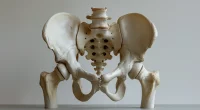Bone Fracture
About the disease
A bone fracture is a damage to the anatomical integrity of a bone. The bone can be injured wholly or partially.
Fractures in adults and children are caused by mechanical impact when the magnitude of the applied force exceeds the strength of the bone tissue. The fracture is most often of traumatic origin. Much less common are congenital variants and pathologic traumatization of bone tissue due to its secondary involvement in the pathologic process.
As practice shows, arms are the most frequently injured (leg fractures are in second place). Bone injuries are usually caused by falls, less frequently by direct impact or road traffic accidents.
A fracture is characterized by a fracture line corresponding to the site of injury to the bone. Depending on the characteristics of this line, fractures are of the following types – transverse, longitudinal, oblique, helical, and spiral. The type of fracture can be determined by X-ray scanning.
The primary diagnostic method is radiologic examination. In complex clinical cases, computed tomography scanning may be helpful.
If there is no displacement of the bone segments or after their successful manual repositioning, a fixation rigid dressing is applied (conservative tactics). If the displacement is significant or manual repositioning is ineffective, surgery is indicated for the fracture.
Types of fractures
Bone injuries are classified into the following types based on the extent of damage:
- complete, when the fracture line divides the bone into two segments;
- incomplete, when there are two fragments at one end of the fracture line and the integrity of the bone is intact at the other end.
Two subtypes are distinguished in the category of incomplete fractures:
- A fracture is a minor injury to a bone due to bending of the bone;
- A fracture is an incomplete fracture variant without a kink (may be marginal).
From a practical point of view, it is essential to distinguish between 2 main types of fractures:
- closed when the skin over the fracture site is intact;
- Open when the fracture is combined with a wound from which bone fragments can be seen.
The location of the fracture line in relation to the joint allows three main types to be distinguished:
- Diaphyseal – does not affect the joint; the bone breaks in the body (diaphysis);
- Epiphyseal – the fracture line runs inside the joint, terminal parts of the bone are broken (e.g., ankle joint and others may be involved);
- Metaphyseal – the fracture line is near the joint but outside the joint.
The fracture’s complexity, which determines the peculiarities of the treatment program, can be different. Based on this criterion, the violation of bone integrity can be of 3 types:
- simple – these are usually closed incomplete fractures that do not lead to the development of complications;
- Complicated – the impact of the traumatic factor extends not only to the bone tissue but also to nearby structures; in particular, internal organs and vessels may be damaged, which is fraught with bleeding;
- combined – fractures are combined with damage to other organs, which is not caused by the fracture itself (for example, the thigh bone is injured and the spleen is ruptured – such an injury may be associated with a fall from a height).
Fractures are also classified according to the following:
- the number of places where the integrity of the bone is compromised – they can be single or multiple;
- location of bone fragments – without displacement (easy category of fractures) and with displacement, if the bone is completely broken in one plane (due to the contraction of muscle fibers attached to the bone, the fragments move away from each other by several centimeters).
Fractures can compromise the integrity of the following bones of the spine (vertebrae), ankle, radius, foot, little finger, collarbone, metatarsal bone, jaw, humerus, hand, nose, femur, skull, tibia, etc.
Symptoms of a fracture
The symptoms of a fracture fall into two categories – localized and general signs.
Local manifestations of the fracture:
- painful sensations in the area of injury, which can be so significant that they result in pain shock;
- immobility of a limb (impaired functional ability);
- soft tissue hemorrhage (bruising);
- change in the typical shape of the limb (if there is displacement of bone fragments);
- Atypical mobility of the limb (considered an absolute sign of a fracture);
- a crunching sensation (called crepitation) that occurs when bone segments rub against each other;
- The presence of a skin wound from which bone fragments may be visible.
Common signs of fracture may be increased body temperature, marked weakness, increased psycho-emotional lability, etc. In the case of profuse bleeding due to vascular damage caused by bone fragments, there may be loss of consciousness and a significant drop in blood pressure.
Causes of fracture
The causes of fractures are different. Therefore, two main types are distinguished:
- congenital – formed at the antenatal stage of life (most often associated with an incomplete bone structure of the fetus);
- acquired, classified into traumatic (caused by the impact of external trauma) and pathological (appear under the influence of a particular disease – syphilitic or tuberculosis process, the growth of tumor tissue, etc.).
The most common cause of fractures is trauma. The direction of the applied mechanical force determines the localization of the fracture. Thus, the humerus is usually injured when falling on the elbow joint or hand. The two bones of the forearm can be injured by a direct blow to the arm in this anatomical region. The lower end of the radius is broken by a fall on an arm in an extended position. The integrity of the bones of the hand, including the fingers, is compromised by direct impact or by a fall with the hand resting on the hand.
Femur fractures are usually common in older people due to the involutional decrease in bone mineral density. In this case, the fracture line is usually in the femoral neck and the acetabular region. The integrity of the patella is broken due to a fall on the knee joint or a direct blow to the knee from the front. High jumps can injure the tibia. A similar mechanism is characteristic of injury to the bones of the foot. The foot can also be injured when heavy objects fall, crushing the bones.
The bones of the body and skull are the least frequently injured. However, such injuries are often hazardous because the structure of internal organs, including the brain and spinal cord, can be affected.
The following factors can cause trauma-associated fractures:
- direct impact, with the break line having a transverse orientation;
- hyperextension that exceeds the strength limit of bone tissue;
- Compression or squeezing (may cause compression fractures, embedded fractures);
- detachment of the tendon compartment from the bone base (detachment fracture);
- torsional impact resulting in helical fractures;
- Gunshot wounds that involve bone shattering and/or shrapnel.
Fracture diagnosis
According to clinical guidelines, the fracture diagnosis is based on evaluating the patient’s complaints, visual examination, and palpation. The final diagnosis is made after radiologic examination in at least two planes. Radiographs allow you to clearly assess the localization and course of the line of injury and the presence or absence of displacement of bone segments. In complex clinical cases, computed tomography may be required.
Treatment of fractures
The quality and timeliness of first aid determines the success of fracture treatment. After the patient is brought to the clinic, the optimal treatment tactics, which can be conservative or operative, are decided.
Conservative treatment
The type of fracture determines the scope of pre-hospital care. If the fracture is open and the bleeding is profuse, the first step is to stop the bleeding by applying a tourniquet with an indication of the exact time when the blood flow was cut off. Foreign objects should also be removed from the wound. When receiving a fracture, it is essential to ensure immobility of the limb. For this purpose, a splint is applied with the above- and below-lying joints grasped.
After taking the patient to the clinic, the traumatologist chooses conservative tactics if there is no displacement of bone fragments. If there is displacement, manual repositioning under anesthesia is possible. If the attempt to restore the anatomical position of the bones is successful, a plaster cast is applied. It provides immobility of the limb, a prerequisite for bone healing (consolidated fracture).
Surgical treatment
Surgical intervention is indicated for severe injuries (multiple and multifocal fractures) and displacement of bone segments. The operation consists of the following stages:
- providing access to the pathologic focus;
- removal of foreign objects, if any;
- reconstructing the anatomy of the bone (repositioning of fragments);
- fixation of the fragments in a physiologic position using screws and plates;
- wound closure;
- plaster cast.
In some clinical situations, skeletal traction may be used for deviated bone segments. In this case, a spoke is inserted into the distal segment and connected to a special apparatus. The weights attached to it gradually shift the fragment in a given direction. Once the segments are in the correct position, a fixation bandage made of plaster is applied.
All these treatment options are available in more than 800 hospitals worldwide (https://doctor.global/results/diseases/bone-fracture). For example, External fixation can be performed in 43 clinics across Germany for an approximate price of $3,093 (https://doctor.global/results/europe/germany/all-cities/all-specializations/procedures/external-fixation).
Prevention
Fracture prevention is directly related to preventing traumatic injury to bone tissue.
Rehabilitation after a fracture
Rehabilitation after a fracture involves functional recovery of the limb. For this purpose, recuperative exercises, physiotherapy, and revitalizing massage are performed.


